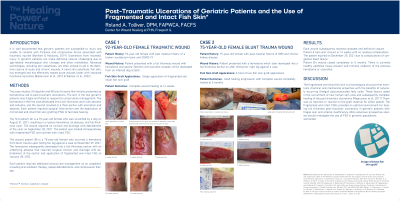Back

Case Series/Study
(CS-139) Post-Traumatic Ulcerations of Vascular Compromised Patients and the Use of Fragmented and Intact Fish Skin

Co-Author(s):
Introduction: Two case studies are presented of ulcerations that developed post trauma, a dog bite and blunt trauma, which were initially seen as hematomas. The skin in the two geriatric patients was fragile and failed to respond to conservative management. The hematoma in the first case developed into a full thickness ulcer with abscess and cellulitis. The hematoma in the second case resulted in a thick eschar with ulceration and abscess. Each patient required surgical intervention and application of fragmented and intact fish-skin grafting to facilitate healing.
Methods: Patient (A), a 92-year-old female bit by a dog penetrating the skin and resulting in hematoma. This subsequently ruptured and an abscess and full thickness ulcer developed. The wound required an incision and drainage with debridement of the ulcer. This was treated intraoperatively with fragmented fish-skin and covered with intact fish-skin.
Patient (B), a 75-year-old female who incurred a hematoma due to blunt trauma upon hitting leg against a vase. The hematoma subsequently developed into a full thickness eschar with underlying abscess. This required surgical incision and drainage with debridement of the eschar and application of fragmented and intact fish-skin.
Results: Each wound subsequently reached complete closure. Patient A had closure of the ulcer in 14 weeks with no residual complications. The patient expired on December 25, 2021 due to complications of congestive heart failure.
Patient B’s wound closed completely in 5 months. There is currently healthy epithelial tissue present and minimal evidence of the previous hematoma or ulceration.
Discussion: The fragmented and intact fish-skin has naturally occurring homologous structure, chemical complexity, mechanical properties and molecular organization with the added benefits of the naturally occurring Omega 3 polyunsaturated fatty acids. These factors aided the recruitment of new human skin cells and subsequently complete healing of the post traumatic ulcerations. There was no rejection or reaction to the graft material for either patient. The combination of the fragmented and intact fish-skin grafts provided an environment for optimal healing potential of full thickness post traumatic ulcerations in patients with arterial insufficiency.
Trademarked Items: *KerecisTM
References:
Methods: Patient (A), a 92-year-old female bit by a dog penetrating the skin and resulting in hematoma. This subsequently ruptured and an abscess and full thickness ulcer developed. The wound required an incision and drainage with debridement of the ulcer. This was treated intraoperatively with fragmented fish-skin and covered with intact fish-skin.
Patient (B), a 75-year-old female who incurred a hematoma due to blunt trauma upon hitting leg against a vase. The hematoma subsequently developed into a full thickness eschar with underlying abscess. This required surgical incision and drainage with debridement of the eschar and application of fragmented and intact fish-skin.
Results: Each wound subsequently reached complete closure. Patient A had closure of the ulcer in 14 weeks with no residual complications. The patient expired on December 25, 2021 due to complications of congestive heart failure.
Patient B’s wound closed completely in 5 months. There is currently healthy epithelial tissue present and minimal evidence of the previous hematoma or ulceration.
Discussion: The fragmented and intact fish-skin has naturally occurring homologous structure, chemical complexity, mechanical properties and molecular organization with the added benefits of the naturally occurring Omega 3 polyunsaturated fatty acids. These factors aided the recruitment of new human skin cells and subsequently complete healing of the post traumatic ulcerations. There was no rejection or reaction to the graft material for either patient. The combination of the fragmented and intact fish-skin grafts provided an environment for optimal healing potential of full thickness post traumatic ulcerations in patients with arterial insufficiency.
Trademarked Items: *KerecisTM
References:

.png)